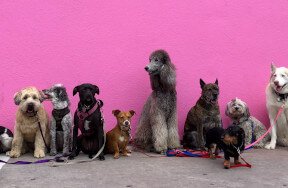 By: Sindy
By: Sindy
Caitlin Ohama-Darcus is an 18 year-old Canadian teen who has been awarded the 2007 TD Canada Trust Scholarship for her work in helping to protect the environment. Kidzworld sat down to chat with her - check out the interview!
Sindy: Tell us a little about the project you created, the Passport to Sustainability.
Caitlin Ohama-Darcus: It was a program started to inspire younger students to make small changes to their lives and develop more sustainable habits. For kindergarten to grade six girls, we developed a program that would enable them every day to keep track of their sustainable actions. So it is basically a passport that every girl received at the beginning of the year and it's divided into about 20 pages with boxes and areas to get stamps. So each teacher in the classroom has a stamp with a paw print, which is our school's logo. For every sustainable action, say packing a litter-less lunch, walking to school, carpooling, recycling, doing something helpful in class, the teacher can award a stamp to the student. It's a way to get students motivated to do these types of very small things and also inspire their families to get on board.
Sindy: Why focus on this young age group?
Caitlin Ohama-Darcus: I thought for the youngest students, they'd probably be the most important group to get on board because they're the ones who, in a couple of years, will be leading the school and also the ones who are going to be the next generation. So if they develop the habits now, in the future it will be so much easier to do this naturally.
Sindy: What are some ways that kids can act in environmentally responsible ways?
Caitlin Ohama-Darcus: There are lots of important actions like walking to school, carpooling, bussing, packing lunches that don't have extra wrappers so using containers instead, recycling, all these different small things. But then there's also the aspect of sustainability that has to do with relationships and interaction with the community, to get students to look around them and see that perhaps going for a walk or helping with a project or planting a flower has two benefits - the environmental side and also the social responsibility side.
Sindy: Where does your passion for the environment come from?
Caitlin Ohama-Darcus: As a child, I used to travel a lot with my mom, play in the garden, be at the farm - my grandparents used to live in Alberta and they had a farm - plant flowers, hike in the forest. And so all these little things taught me a lot about seeing the world around me and seeing how my own actions had an impact, even the smallest things. And that has stayed with me until now and is the main inspiration behind everything.
Sindy: What do you do in your day-to-day life to help protect the environment?
Caitlin Ohama-Darcus: Definitely reducing as much consumption as possible. A lot of it has to do with mindset, respect and enthusiasm towards the subject, not just standing back and thinking, "Okay, what I'm doing today is not going to have any impact, so I can do just whatever I want" but thinking about it. And even if I don't go the whole way by not ever driving in a car or something like that, the fact that I acknowledge that it is having an impact and that there are certain things that can be done to change it, to make up for whatever's happening. I try to walk to school every day, things like that. It can be done, and acknowledging what role you play is most important.
Sindy: All the work you've done to raise awareness for environmental sustainability helped you win a Community Leadership scholarship. What do you plan to do with it?
Caitlin Ohama-Darcus: Well, the scholarship pays for all of my undergraduate studies and I couldn't ask for a better gift. It takes a lot of worries off my mind and I can focus on studies and doing community work.
Sindy: Do you have any advice for kids who want to start similar projects in their communities?
Caitlin Ohama-Darcus: Always keep in mind what the real purpose of a project is. It's so easy to get bogged down by prices and decisions and even politics within an institution. Just keep in mind that the purpose of a project is to, say build a school or inspire younger students. With that in mind, you can get it done and inspire everyone else around you - whoever is helping, adults, teachers - to have similar enthusiasm towards the common goal because it's very easy to get lost in the details.
Sindy: Any last words you'd like to say to get kids more involved and more aware of pressing environmental issues?
Caitlin Ohama-Darcus: I think awareness is the key word in the media now. There is growing awareness. I'm not always thrilled with the way things like sustainability and global warming are being presented, but I think it's great that suddenly this is a household word and people, even young children, recognize that it is. So for younger people to keep building their own opinions regarding things like global warming because there are so many different sources and opinions being presented by environmental interest groups, political groups, even environment clubs at school, but if each child can feel confident that their own opinion regarding the matter is the right one, I think is the most important because then that way, you feel personally connected with what you're doing and what you can do to change or help what's happening around you.
Related Stories:






























